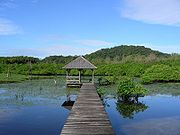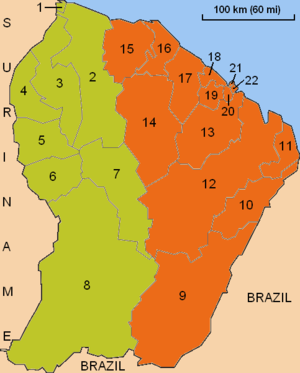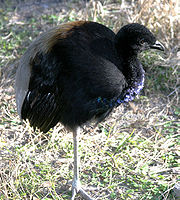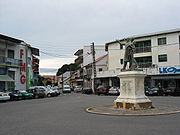
French Guiana
About this schools Wikipedia selection
SOS Children produced this website for schools as well as this video website about Africa. Sponsoring children helps children in the developing world to learn too.
| French Guiana Guyane  |
|||
|---|---|---|---|
| — Overseas region of France — | |||
|
|||
| Country | |||
| Prefecture | Cayenne | ||
| Departments | 1 | ||
| Government | |||
| • President | Rodolphe Alexandre ( UMP, region) Alain Tien-Liong ( MDES, department) |
||
| Area | |||
| • Total | 83,534 km2 (32,253 sq mi) | ||
| Population (Jan. 2009) | |||
| • Total | 217,000 | ||
| • Density | 2.6/km2 (6.7/sq mi) | ||
| Time zone | GFT ( UTC-03) | ||
| GDP/ Nominal | € 3.2 billion (2008) | ||
| GDP per capita | € 14,204 (US $20,904) (2008) | ||
| NUTS Region | FR9 | ||
| Website | region, department | ||
French Guiana (French: Guyane française, IPA: [ɡɥijan fʁɑ̃sɛz]; officially just Guyane) is an overseas region of France, consisting of a single overseas department (French: département d'outre-mer, or DOM) located on the northern Atlantic coast of South America. It has borders with two nations, Brazil to the east and south, and Suriname to the west. Its 83,534 km² have a very low population density of less than three inhabitants per km², with almost half of its 229,000 people in 2009 living in the urban area of Cayenne, its capital. French Guiana's currency is the euro.
The addition of the adjective "French" in English comes from colonial times when four such colonies existed, namely from west to east: British Guiana (now Guyana), Dutch Guiana (now Suriname), French Guiana, and Portuguese Guiana (now Amapá the northeastern most state of Brazil). The first three are still often collectively referred to as the Guianas.
History
French Guiana was originally inhabited by a number of indigenous American people. It was settled by the French during the 17th century. After the Treaty of Paris in 1763, Louis XV sent 12,000 settlers to French Guiana to colonise the region. One and a half years later only a few hundred survived. Its infamous Île du Diable ( Devil's Island) was the site of penal settlements from 1852 until 1951. More than 70,000 French convicts were deported to French Guiana between 1852 and 1939.
In 1809, a Portuguese-British naval squadron took French Guiana for the Portuguese Empire. With the signing of the Treaty of Paris in 1814 the region was handed back to the French, though a Portuguese presence remained until 1817.
A border dispute with Brazil arose in the late 19th century over a vast area of jungle, leading to the short-lived pro-French independent state of Counani in the disputed territory and some fighting between settlers, before the dispute was resolved largely in favour of Brazil by the arbitration of the Swiss government.
In 1946, French Guiana became an overseas department of France. The 1970s saw the settlement of Hmong refugees from Laos.
In 1964 the president decided to construct a space-travel base in Guiana. This would replace the existing Sahara base in Algeria and stimulate economic growth in Guiana. The department is peculiarly suitable for the purpose both because it is near to the equator and because of the extensive access to a large ocean. The Guiana Space Centre a short distance along the coast from Kourou has grown considerably since the initial launches of the ’Véronique’ rockets, and has brought commercial success to the European space industry with launchers such as the Ariane 4 et Ariane 5.
A movement for increased autonomy from France gained some momentum in the 1970s and 1980s, but has since abated.
Geography
Though sharing cultural affinities with the French-speaking territories of the Caribbean, French Guiana is not considered to be part of that geographic region, because the Caribbean Sea is actually located several hundred kilometres to the west, beyond the arc of the Lesser Antilles. However, the boundaries of what people have defined as the Caribbean today has changed. Historically, the boundaries of the Caribbean were at their greatest extent during the 17th and 18th centuries and as such French Guiana was situated on the edge and during some periods maybe thought to be part of the Caribbean proper.
French Guiana consists of two main geographical regions: a coastal strip where the majority of the people live, and dense, near-inaccessible rainforest which gradually rises to the modest peaks of the Tumac-Humac mountains along the Brazilian frontier. French Guiana's highest peak is Bellevue de l'Inini (851 m). Other mountains include Mont Machalou (782 m), Pic Coudreau (711 m) and Mont St Marcel (635 m), Mont Favard (200 m) and Montagne du Mahury (156 m). Several small islands are found off the coast, the three Iles du Salut Salvation Islands which includes Devil's Island and the isolated Iles du Connétable bird sanctuary further along the coast towards Brazil.
The Barrage de Petit-Saut hydroelectric dam in the north of French Guiana forms an artificial lake and provides hydroelectricity. There are many rivers in French Guiana. Like the Waki River
As of 2007, the Amazonian forest located in the most remote part of the department is now protected through one of the nine national parks of France, the Guiana Amazonian Park. The territory of the park covers some 33,900 square kilometres (13,090 sq mi) upon the communes of Camopi, Maripasoula, Papaïchton, Saint-Élie and Saül.
Administrative divisions
French Guiana is divided into 2 arrondissements, 19 cantons (not shown here), and 22 communes:
| Arrondissement of Saint-Laurent-du-Maroni |
Arrondissement of Cayenne |
|---|---|
|
|
Climate
| Climate data for French Guiana (Cayenne) | |||||||||||||
|---|---|---|---|---|---|---|---|---|---|---|---|---|---|
| Month | Jan | Feb | Mar | Apr | May | Jun | Jul | Aug | Sep | Oct | Nov | Dec | Year |
| Record high °C (°F) | 33 (91) |
34 (93) |
33 (91) |
33 (91) |
33 (91) |
34 (93) |
34 (93) |
36 (97) |
36 (97) |
36 (97) |
35 (95) |
34 (93) |
36 (97) |
| Average high °C (°F) | 27 (81) |
28 (82) |
28 (82) |
28 (82) |
28 (82) |
28 (82) |
29 (84) |
30 (86) |
31 (88) |
30 (86) |
30 (86) |
28 (82) |
29 (84) |
| Average low °C (°F) | 23 (73) |
23 (73) |
23 (73) |
23 (73) |
23 (73) |
23 (73) |
23 (73) |
22 (72) |
22 (72) |
22 (72) |
22 (72) |
23 (73) |
23 (73) |
| Record low °C (°F) | 19 (66) |
20 (68) |
19 (66) |
18 (64) |
20 (68) |
21 (70) |
20 (68) |
20 (68) |
21 (70) |
20 (68) |
20 (68) |
20 (68) |
19 (66) |
| Precipitation cm (inches) | 38 (15) |
32 (12.6) |
38 (15) |
38 (15) |
51 (20.1) |
39 (15.4) |
20 (7.9) |
10 (3.9) |
4 (1.6) |
5 (2) |
12 (4.7) |
29 (11.4) |
320 (126) |
| Source: BBC Weather | |||||||||||||
Environment
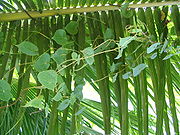
Guiana is home to many unique and important ecosystems: tropical rainforests, coastal mangroves, savannahs, inselbergs and many types of wetlands. Guiana has one of highest levels of biodiversity in the world, in terms of both flora and fauna. This is due to the presence of old-growth forests (i.e. ancient/primary forests), which are biodiversity hotspots. The rainforests of Guiana provide shelter for many species during dry periods and terrestrial glaciation. These forests are protected by a national park (the Guiana Amazonian Park) and six additional nature reserves. The International Union for Conservation of Nature (IUCN) and the European Union (EU) have recommended special efforts to protect these areas.
Following the Grenelle Environment Round Table of 2007, the Grenelle Law II was proposed in 2009, under law number 2010-788. Article 49 of the law proposed the creation of a single organization responsible for environmental conservation in Guiana. The proposed organization would combine expertise in the fields of zoology (flora and fauna) and ecology (functioning of ecosystems), and would contribute to the implementation of policies set forth by state and local authorities. Article 64 proposes a "departmental plan of mining orientation" for Guiana, which would promote mining (specifically of gold) that is compatible with requirements for environmental protection. The coastal environment along the N1 has historically experienced the most changes, but development is occurring locally along the N2, and also in western Guiana due to gold mining.
5,500 plant species have been recorded, including more than a thousand trees, along with 700 species of birds, 177 species of mammals, over 500 species of fish including 45% of which are Endemic and 109 species of amphibians. The micro-organisms would be much more numerous, especially in the north, which competes with the Brazilian Amazon, Borneo and Sumatra. This is the French department has at least 98% of vertebrate fauna and 96% of vascular plants of France.
The threats to the ecosystem are habitat fragmentation by the roads, which remains very limited compared to other forests of South America, impacts of immediate and deferred Dam Small-jump of EDF of gold mining, poor control of a hunting and poaching facilitated by the creation of many tracks and the appearance of All-terrain vehicles. Logging remains moderate because of the lack of roads, on both the difficulty of climate and terrain. An ordinance of 28 July 2005 extended the Forest Code at French Guiana, but with important exceptions and modifications. In an approach that will be sustainable, concessions or free transfers may be granted by local authorities or other entities for use by persons traditionally deriving their livelihood from the forest, but the means no longer always used traditional means, and the Guianese ecosystem being vulnerable, the impacts of logging or hunting may be important.
The beaches of the natural reserve of the Amana, the joint Awala-Yalimapo in the west, is a marine turtle nesting site exceptional. This is one of the largest worldwide for the leatherback turtle.
Agriculture
Guiana has some of the poorest soils in the world. The soil is low in nutrients (e.g. nitrogen, potassium) and organic matter. Soil acidity is another cause of the poor soils, and it requires farmers to add lime to their fields. All of these soil characteristics have led to the use of slash and burn agriculture. The resulting ashes elevate soil pH (i.e. lower soil acidity), and contribute minerals and other nutrients to the soil. Sites of Terra preta ( anthropogenic soils) have been discovered in Guiana, particularly near the border with Brazil. Research is being actively pursued in multiple fields to determine how these enriched soils were historically created, and how this can be done in modern times.
Economy
In 2008, the GDP of French Guiana at market exchange rates was US$4.72 billion (€3.21 billion), ranking as the largest economy in the Guianas, and the 11th largest in South America.
French Guiana is heavily dependent on mainland France for subsidies, trade, and goods. The main industries are fishing (accounting for three-quarters of foreign exports), gold mining and timber. In addition, the Guiana Space Centre at Kourou accounts for 25% of the GDP and employs about 1,700 people.
There is very little manufacturing. Agriculture is largely undeveloped and is mainly confined to the area near the coast — sugar and bananas are two of the main cash crops grown. Tourism, especially eco-tourism, is growing. Unemployment is a major problem, running at about 20% to 30%.
In 2008, the GDP per capita of French Guiana at market exchange rates, not at PPP, was US$20,904 (€14,204), the highest in South America, but only 47% of Metropolitan France's average GDP per capita that year.
| 1999 | 2000 | 2001 | 2002 | 2003 | 2004 | 2005 | 2006 | 2007 | |
|---|---|---|---|---|---|---|---|---|---|
| French Guiana | 64 | 53 | 60 | 60 | 56 | 52 | 53 | 50 | 49 |
| France | 115 | 115 | 116 | 116 | 112 | 110 | 111 | 109 | 108 |
Demographics
French Guiana's population of 229,000 (January 2009 est.), most of whom live along the coast, is very ethnically diverse. At the 1999 census, 54.4% of the inhabitants of French Guiana were born in French Guiana, 11.8% were born in Metropolitan France, 5.2% were born in the French Caribbean départements (Guadeloupe and Martinique), and 28.6% were born in foreign countries (primarily Brazil, Suriname, and Haiti).
Estimates of the percentages of French Guiana ethnic composition vary, a situation compounded by the large proportion of immigrants (about 20,000, nearly 10%).
Creoles (people of mixed African and French ancestry) are the largest ethnic group, though estimates vary as to the exact percentage, depending upon whether the large Haitian community is included as well. Generally the Creole population is judged to be about 60% to 70% of the total population if Haitians (comprising roughly one-third of Creoles) are included, and 30% to 50% without.
Roughly 14% of the population is of European ancestry. The vast majority of these are of French heritage, though there are also people of Dutch, British, Spanish and Portuguese ancestry .
The main Asian communities are the Chinese (3.2%, primarily from Hong Kong and Zhejiang province) and Hmong from Laos (1.5%). There are also smaller groups from various Caribbean islands, mainly Saint Lucia as well as Dominica. Other Asian groups include East Indians, Lebanese and Vietnamese.
The main groups living in the interior are the Maroons (formerly called "Bush Negroes") who are racially black African, and Amerindians. The Maroons, descendants of escaped African slaves, live primarily along the Maroni River. The main Maroon groups are the Saramaca, Aucan (both of whom also live in Suriname), and Boni (Aluku).
The main Amerindian groups (forming about 3%-4% of the population) are the Arawak, Carib, Emerillon, Galibi (now called the Kaliña), Palikour, Wayampi and Wayana. As of late 1990s, there was evidence of an uncontacted group of Wayampi.
The dominant religion of French Guiana is Roman Catholicism; the Maroons and some Amerindian people maintain their own religions. The Hmong people are also mainly Catholic owing to the influence of missionaries who helped bring them to French Guiana.
| 1790 estimate |
1839 estimate |
1857 estimate |
1891 estimate |
1946 census |
1954 census |
1961 census |
1967 census |
1974 census |
1982 census |
1990 census |
1999 census |
2007 census |
2009 estimate |
|
|---|---|---|---|---|---|---|---|---|---|---|---|---|---|---|
| 14,520 | 20,940 | 25,561 | 33,500 | 25,499 | 27,863 | 33,505 | 44,392 | 55,125 | 73,022 | 114,678 | 156,790 | 213,029 | 229,000 | |
| Official figures from past censuses and INSEE estimates. | ||||||||||||||
Fertility
The total fertility rate in French Guiana has remained high and is today considerably higher than in Metropolitan France, and also higher than the average of the four French overseas departments. It is largely responsible for the high population growth of French Guiana.
| 1999 | 2000 | 2001 | 2002 | 2003 | 2004 | 2005 | 2006 | 2007 | |
|---|---|---|---|---|---|---|---|---|---|
| French Guiana | 3.87 | 3.93 | 3.79 | 3.73 | 3.77 | 3.47 | 3.79 | 3.80 | 3.71 |
| Four overseas departments | 2.32 | 2.45 | 2.42 | 2.35 | 2.38 | 2.40 | 2.46 | 2.48 | 2.50 |
| Metropolitan France | 1.79 | 1.87 | 1.88 | 1.86 | 1.87 | 1.90 | 1.92 | 1.98 | 1.96 |
| Source: INSEE | |||||||||
Languages
The official language of French Guiana is French, but a number of other local languages exist. Regional languages include French Guiana creole, six Amerindian languages ( Arawak, Palikur, Kali'na, Wayana, Wayampi, Emerillon), four Maroon dialects ( Saramaka, Paramaccan, Boni, Djuka), as well as Hmong Njua. Other languages spoken include Portuguese, Hakka, Haitian Creole, Spanish, Dutch and English.
Politics
French Guiana, as part of France, is part of the European Union, the largest landmass for an area outside of Europe (since Greenland left the European Community in 1985), with one of the longest EU external boundaries. Along with the Spanish enclaves in Africa of Ceuta and Melilla, it is one of only three European Union territories outside Europe that is not an island. As an integral part of France, its head of state is the President of the French Republic, and its head of Government is the Prime Minister of France. The French Government and its agencies have responsibility for a wide range of issues that are reserved to the National Executive, such as defense and external relations.
The President of France appoints a Prefect (resident at the Prefecture building in Cayenne) as his representative to head the local government of French Guiana. There are two legislative bodies: the 19-member General Council and the 34-member Regional Council, both elected.
French Guiana sends two deputies to the French National Assembly, one representing the commune (municipality) of Cayenne and the commune of Macouria, and the other representing the rest of French Guiana. This latter constituency is the largest in the French Republic by land area. French Guiana also sends one senator to the French Senate.
French Guiana has traditionally been conservative, though the Socialist Party has been increasingly successful in recent years.
A chronic issue affecting French Guiana is the influx of illegal immigrants and clandestine gold prospectors from Brazil and Suriname. The border between the department and Suriname is formed by the Maroni River, which flows through rain forest and is difficult for the Gendarmerie and the French Foreign Legion to patrol. There have been several phases launched by the French government to combat illegal gold mining in French Guiana, beginning with Operation Anaconda beginning in 2003, followed by Operation Harpie in 2008, 2009 and Operation Harpie Reinforce in 2010. Colonel François Müller, the commander of French Guiana's gendarme believes these operations have been successful. However, after each operation ends, Brazilian miners, Garimpeiros, return. Soon after Operation Harpie Reinforce began, an altercation took place between French authorities and Brazilian miners. On March 12, 2010, a team of French soldiers and border police were attacked while returning from a successful operation, during which "the soldiers had arrested 15 miners, confiscated three boats, and seized 617 grams of gold... currently worth about $22,317." Garimpeiros returned to retrieve the lost loot and colleagues. "The soldiers fired warning shots and rubber "flash balls" but the miners managed to retake one of their boats and about 500 grammes of gold. “The violent reaction by the Garimpeiros can be explained by the exceptional take of 617 grammes of gold, about 20 percent of the quantity seized in 2009 during the battle against illegal mining,” said Phillipe Duporge, the director of French Guiana’s border police, at a press conference the next day."
Transport
French Guiana's main international airport is Cayenne-Rochambeau Airport, located in the commune of Matoury, a southern suburb of Cayenne. There are two flights a day to Paris ( Orly Airport), served by Air France and Air Caraïbes. The flight time from Cayenne to Paris is 8 hours and 25 minutes, and from Paris to Cayenne it is 9 hours and 10 minutes. There are also flights to Fort-de-France, Pointe-à-Pitre, Port-au-Prince, Miami and Belém.
French Guiana's main seaport is the port of Dégrad des Cannes, located on the estuary of the Mahury River, in the commune of Remire-Montjoly, a south-eastern suburb of Cayenne. Almost all of French Guiana's imports and exports pass through the port of Dégrad des Cannes. Built in 1969, it replaced the old harbour of Cayenne which was congested and couldn't cope with modern traffic.
An asphalted road from Régina to Saint-Georges de l'Oyapock (a town by the Brazilian border) was opened in 2004, completing the road from Cayenne to the Brazilian border. It is now possible to drive on a fully paved road from Saint-Laurent-du-Maroni on the Surinamese border to Saint-Georges de l'Oyapock on the Brazilian border.
Following an international treaty between France and Brazil signed in July 2005, the Oyapock River Bridge over the Oyapock River (marking the border with Brazil) is currently being built and is due to open in 2010. This bridge will be the first land crossing ever opened between France and Brazil, and indeed between French Guiana and the rest of the world (there exists no other bridge crossing the Oyapock River, and no bridge crossing the Maroni River marking the border with Suriname - there is a ferry crossing to Albina, Suriname). When the bridge is opened, it will be possible to drive uninterrupted from Cayenne to Macapá, the capital of the state of Amapá in Brazil.
Main Settlements (2007)
- Cayenne 58369
- Saint-Laurent du Maroni 34336
- Kourou 25918
- Matoury 25191
- Remire-Montjoly 18947
- Mana 8322
- Macouria 8386
- Apatou 6360
- Maripasoula 5584
- Saint-Georges 3692
- Grand-Santi 3430
- Sinnamary 3137
Armed Forces in French Guiana
Since July 2009, the commander of French Guiana's armed forces is General Jean-Pierre Hestin. The military there is currently 1900-strong, expected to increase enrollment in 2014-2015.
French Guiana's military is made up of:
- The 3rd Foreign Infantry Regiment (3 ((e)) REI) of Kourou ( Legion)
- The 9th Marine Regiment (9 ((e)) RIMa) of Cayenne, the Madeleine.
- The police, divided into 16 brigades. These serve Cayenne, Remire-Montjoly, Cacao, Régina, Saint-Georges-de-l'Oyapock, Camopi, Macouria, Kourou , Sinnamary, Iracoubo, Mana, Saint Laurent du Maroni, Apatou, Grand-Santi, Papaïchton, Maripasoula and Matoury.
- The RSMAG Regiment ( Adapted Military Service) of Guyana, located in Saint-Jean-du-Maroni, with a detachment in Cayenne.
- Various detachments corps:
- An Air Force platoon based at the Rochambeau 367 airport.
- The platoon of the Navy, based at the naval base of Degrad-des-Cannes
- A detachment of the Brigade firefighters Paris in Kourou, ensuring the protection of the CSG



